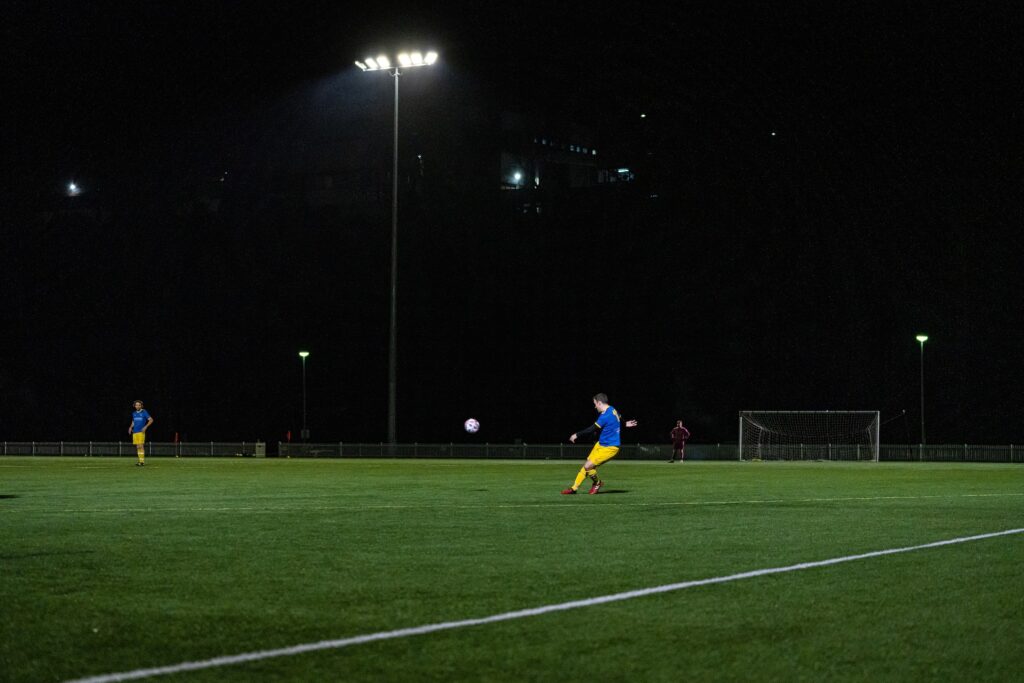Table of Contents
- What is an indirect free kick in soccer?
- What is a direct free kick in soccer?
- Recap: Indirect free kick in soccer vs. direct free kick
- Further reading on an indirect free kick in soccer
Indirect free kick in soccer – what on earth is it, why is it awarded, and how is it different from a direct free kick? Well, we’re pleased you asked!
When a foul is committed on the soccer field, there are two types of free kicks that the referee can award – indirect and direct free kicks.
But what’s the difference between the two? Which offenses lead to which? And what do you need to know when planning to make the most of a free kick on the soccer field? Let’s find out.
What is an indirect free kick in soccer?
An indirect free kick is awarded by the referee for specific fouls and offenses. Indirect means that you cannot score with a direct shot on goal; the ball must touch another player (either a teammate or opponent) before entering the net.
Offenses that lead to an indirect free kick
There are a number of offenses on the soccer field that warrant the award of an indirect free kick, and it’s important to be aware of them. They include:
- Dangerous play that risks the safety of an opponent (for instance, raising your foot too high off the ground when challenging your opponent).
- Impeding your opponent without making any contact with them – contact results in a direct free kick.
- Dissent – the use of offensive or abusive language toward anyone on or off the field.
- Preventing the goalkeeper from releasing the ball.
- Simulation or attempting to deceive the referee in any way.
- Being offside.
Indirect free kicks can be awarded anywhere on the soccer pitch, even in the penalty area that you are attacking. Provided that the offense that is committed is in line with one of those above, the referee would award an indirect free kick instead of a penalty, even though the offense has been committed inside the eighteen-yard box. This can certainly be confusing for beginners, but it’s important to recognize!
How does the referee signify an indirect free kick in soccer?
During a game, you might not know right away that the referee has awarded an indirect free kick, which can cause a few potential issues before you and your teammates decide on how best to take the set play.
Helpfully, when the referee awards an indirect free kick in soccer, they raise their arm directly in the air. The referee must hold their arm in the air until the ball is touched by another player, signifying that the game can continue.
So, if your team is awarded a free kick in a promising position, but the referee raises their arm aloft, you know that you must arrange the play to ensure that another person touches the ball before it enters the net.
What happens if you score from an indirect free kick?
As mentioned, an indirect free kick means that you cannot score directly from a shot. So, you line up a shot, and it goes directly into the net without touching anyone else; it doesn’t count. Instead, the referee awards a goal kick to the opposing team as the ball leaves the field behind the goal line.
While frustrating, there’s not much you can do about this, as it’s just one of the rules of the game! So, if you’re awarded an indirect free kick, make sure that one of your teammates touches the ball before you shoot. Equally, you could try and force a deflection off one of your opponents, which is also permissible.
What is a direct free kick in soccer?

A direct free kick is awarded by the referee when a foul is committed – this is the most common type of free kick in soccer. When awarded a direct free kick, you can take a shot at goal, and it doesn’t need to touch another player before entering the net.
Offenses that lead to a direct free kick in soccer
The vast majority of free kicks that are awarded during a soccer game are direct, meaning that you can score directly with a shot on goal. Specifically, the offenses that lead to the referee awarding a direct free kick in soccer include:
- Charging, jumping, kicking, pushing, or striking an opponent in a manner that is deemed to be careless or reckless. If the referee deems that a player has used excessive force in a challenge, the referee will issue a red card.
- Tackling or tripping an opponent without playing the ball first.
- Handling the ball – this excludes the goalkeeper handling the ball in the penalty area, of course, or when an outfield player takes a throw-in.
- Biting, spitting, or throwing the ball directly at an opponent or match official.
Essentially, any offense committed by a player that makes contact with an opponent (or even a teammate) results in a direct free kick being awarded to the other team. But remember, soccer is a contact sport, so the referee must first decide that the contact made is worthy of a foul. This is often a cause for contention between players and referees, but remember, the referee’s word is final, and you must respect it.
How does the referee indicate a direct free kick in soccer?
The referee indicates a direct free kick by blowing the whistle for a foul before directing their arm in the direction of the team that is awarded the free kick. However, there’s no need for the referee to keep their arm outstretched – once they award the free kick, they simply drop their arm back down to their side.
As long as the referee doesn’t hold up their arm in the air, it means that you have been issued a direct free kick. If you’re not sure, you can always ask the referee, and they will inform you of whether you have been given a direct or indirect free kick for the foul committed.
Do you need to have a shot from a direct free kick?
No, just because you can shoot, it doesn’t mean that you have to. When you are awarded a direct free kick in soccer, it simply means that you have the right to take a shot at goal, and the ball doesn’t need to touch another player before entering the net.
Most players only take a shot with a direct free kick within roughly thirty yards of the goal. After all, if you’re further away than that, it doesn’t really make sense to test the goalkeeper, as you will struggle to cause problems from so far away from goal!
Recap: Indirect free kick in soccer vs. direct free kick
Both indirect and direct free kicks are an important part of any soccer game, and understanding the differences between them is important. When your team is awarded a free kick, you will need to develop a plan to make the most out of it.
The crucial thing to remember is that with a direct free kick, you can take a shot at goal, while an indirect free kick means that the ball must touch another player before entering the goal.
Further reading on an indirect free kick in soccer
If you want to read up on the rules associated with the award of indirect and direct free kicks, take a look at Law 12 of the Football Association entitled Fouls and Misconduct.

